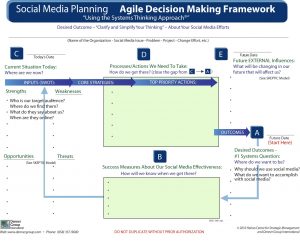Agile Decision Making Framework is Flexible
The answer is Yes, you can! The question is, can you use the Agile Decision Making Framework for anything besides strategic planning?
 The beauty of the Agile Decision Making Framework is that it can be applied to any type of project – even marketing and social media planning. The framework helps you focus your thinking by answering five strategic questions as you work your way around the template.
The beauty of the Agile Decision Making Framework is that it can be applied to any type of project – even marketing and social media planning. The framework helps you focus your thinking by answering five strategic questions as you work your way around the template.
Many social media plans I’ve seen start with identifying your ideal customer and their specific needs. While this is important, it’s not the place to start.
Define your outcomes first
As with strategic planning, you need to start with your future outcomes. That way the actions you take are designed to help you achieve those outcomes. Otherwise, you’re just throwing spaghetti on the wall and hoping some of it sticks.
Using the Agile Decision Making Framework, start with Phase A, answering the question, Where do we want to be? What do you want to accomplish through social media marketing? They should support the higher level outcomes of your organization’s overall strategic plan. Once you’ve determined which social media outcomes can help support those, you can begin to focus on your ideal customers and their needs. In the process, you’ll need to also identify which social media platforms they use the most so you focus your efforts there when you’re ready to take action.
Once you’ve completed Phase A, move on the Phase E. This will help you identify the future external factors that could have an impact on the actions you take today. These become your future Opportunities and / or Threats that you need to consider so you’re prepared to respond should any of them occur. Why look at the external environment you ask? Because your business doesn’t operate in a vacuum. What happens locally and even globally can have profound effects on your customers, their needs, and their desires for your products and services.
With social media, you have to continually be tracking these future trends because new platforms emerge and popular ones lose favor. You don’t want to be stuck on an island by  yourself after your customers have moved over to another platform. If you don’t periodically focus on Phase E, you could be missing the boat!
yourself after your customers have moved over to another platform. If you don’t periodically focus on Phase E, you could be missing the boat!
Once you’ve reviewed Phases A and E, you can move on to Phase B. This is where you identify the specific targets you want to reach and track through social media, answering the question, How will we know when we get there?
These may include the number of click throughs on your links, or a specific increase in customer engagement on your Facebook page, or a percentage increase in website traffic and/or subscribers to your email list. The more specific, the better, so you can track your efforts and see what progress you’re making.
Phase C comes next, answering the question, Where are we today? The first three phases were focused on your future outcomes, your ideal customer’s needs, external trends, and specific goals. This phase looks at your current situation. What are your Strengths and Weaknesses related to social media? Are you just starting? Do you have a strong team working in this area? Do you need to hire a consultant to help? How well do you know the various platforms – Facebook, Twitter, LinkedIn, Google+, Pinterest, etc.? How well versed are you with Google Analytics and Google Adwords? Those are the kinds of skill sets you want to list under your Strengths and Weaknesses. You should also fill out the Opportunities and Threats areas, which came from the external scan you did in Phase E.
By now, you should begin to see some major themes evolving. These become your high level strategies which you list under Phase D, answering the question, How will we get there? These are the specific actions you need to implement to close the gap between your current situation and your future outcomes. Some high level strategies might be training, hiring external talent, creating a social media policy, and customer engagement. Under each strategy will be specific actions you need to take, such as finding online training webinars, advertising for talent, researching social media policies you might adapt to your organization, and creating a content calendar.
Using the Agile Decision Making Framework makes the process of creating your social media plan fairly simple and fast. The next step is to write it up and share it with your team. Then start to implement it!
